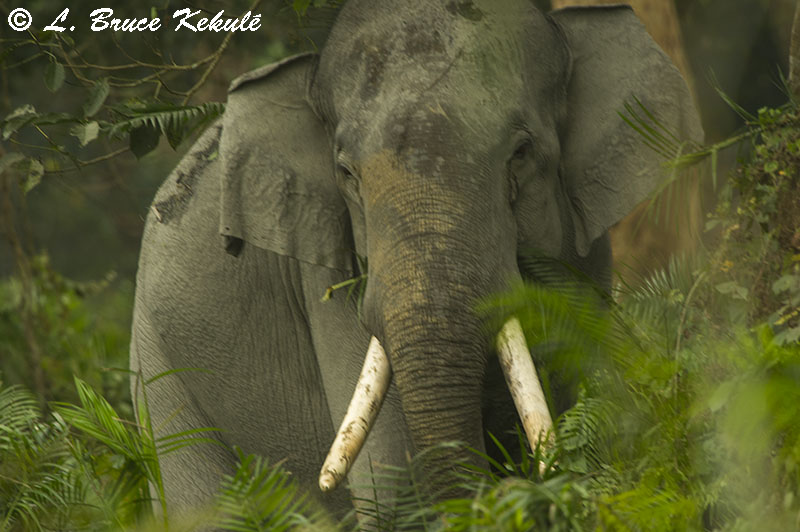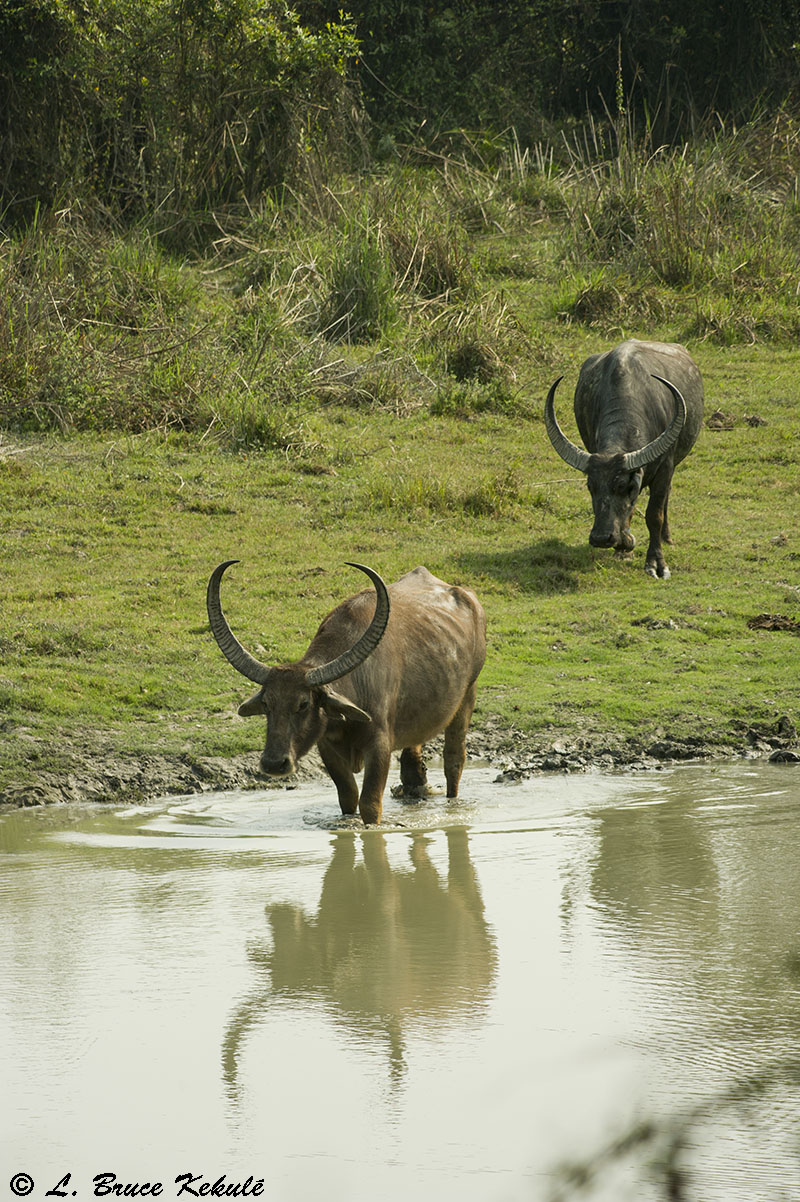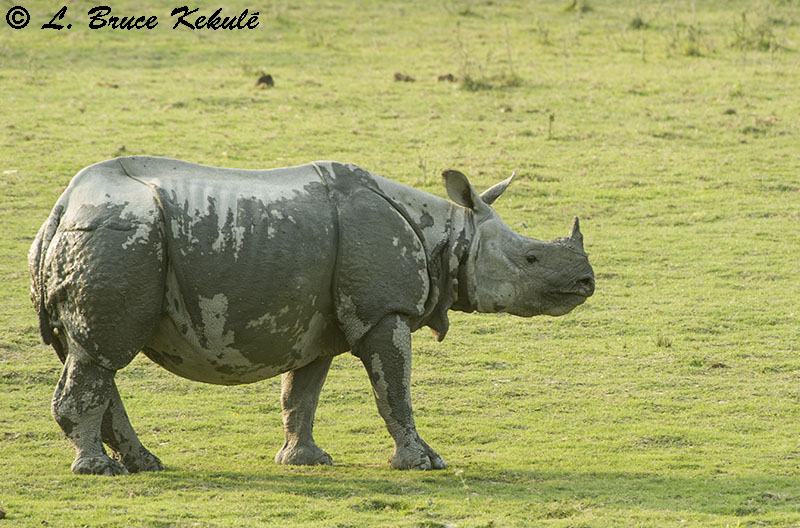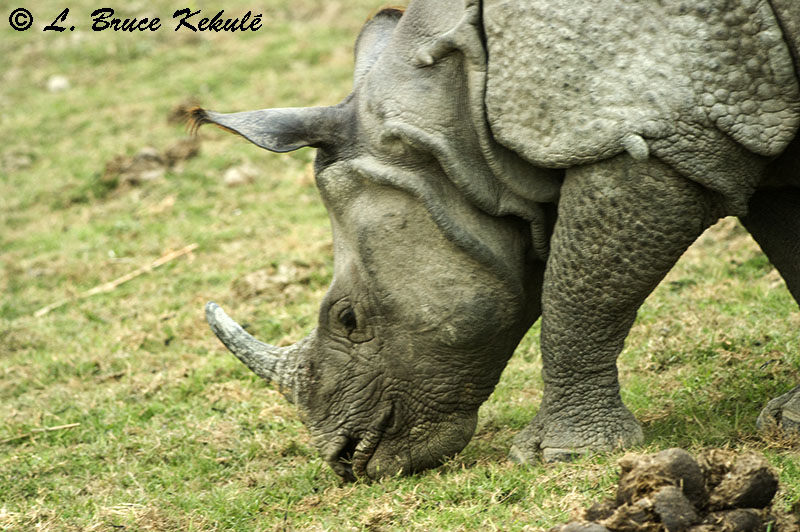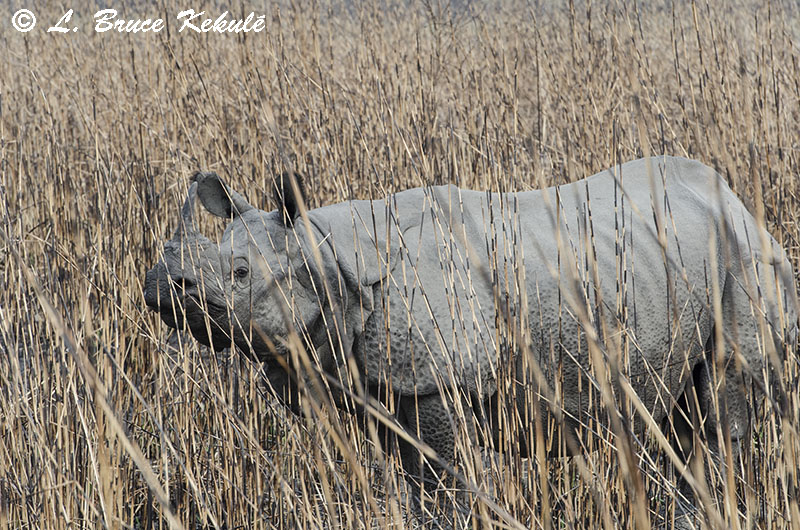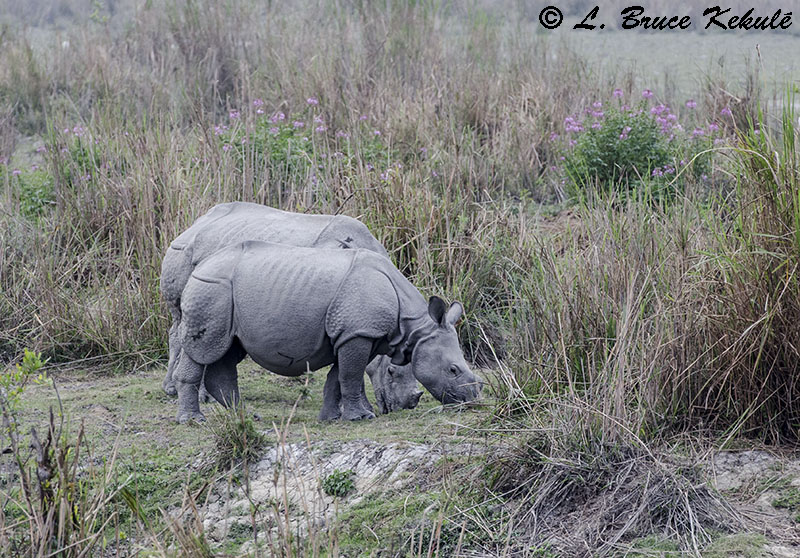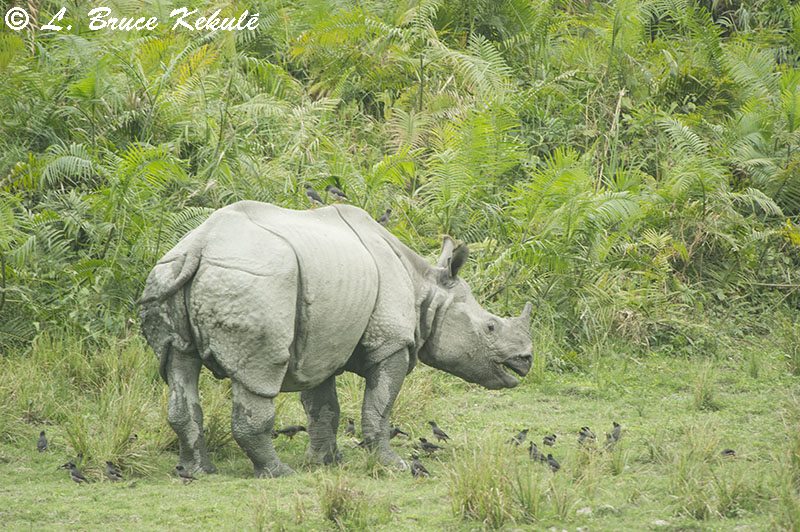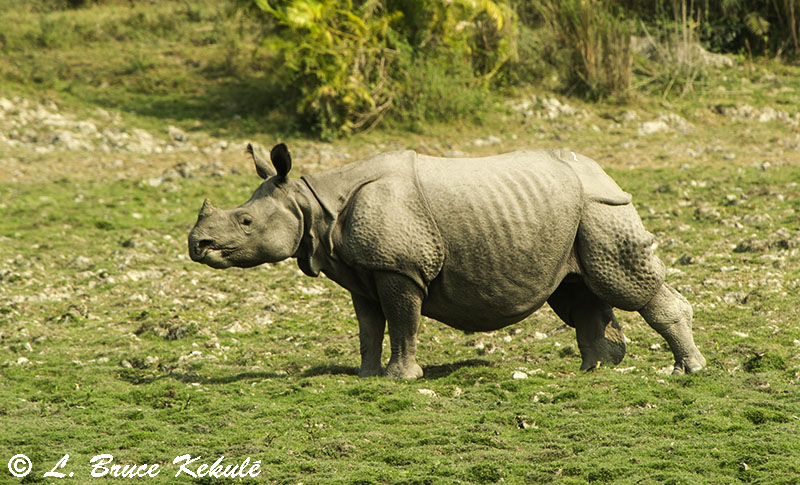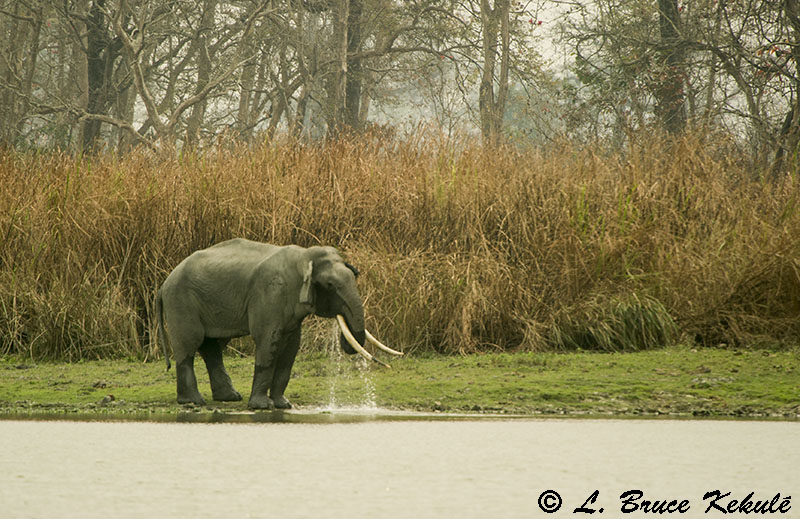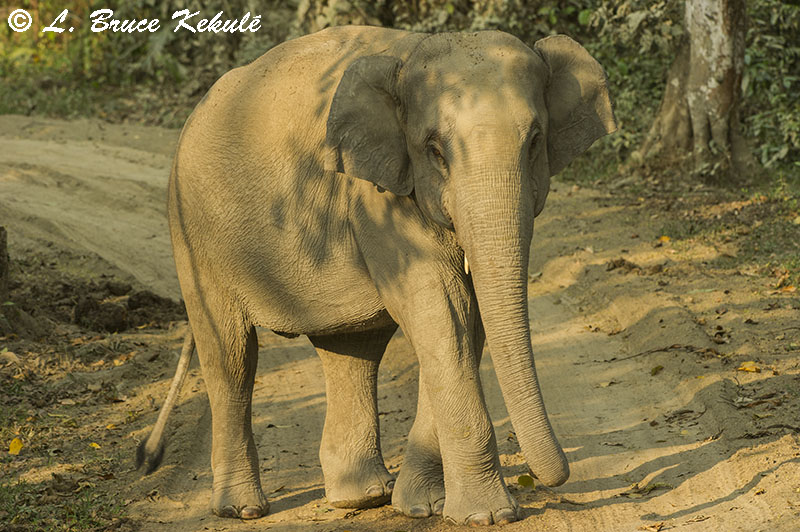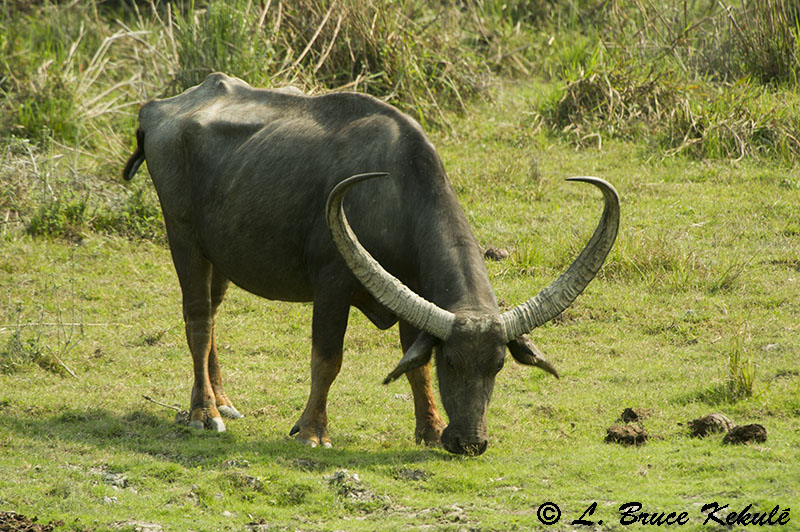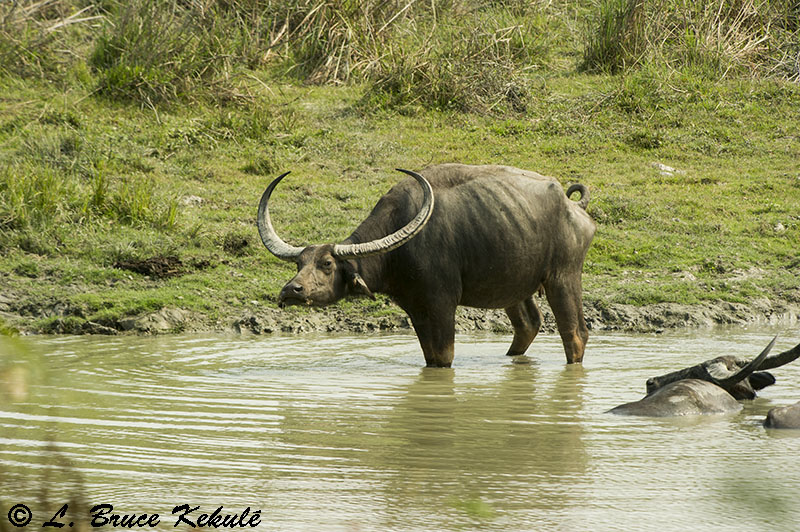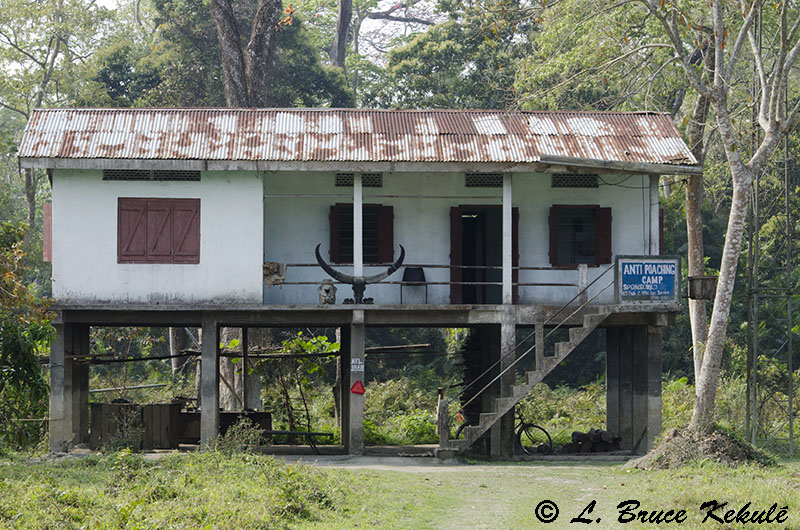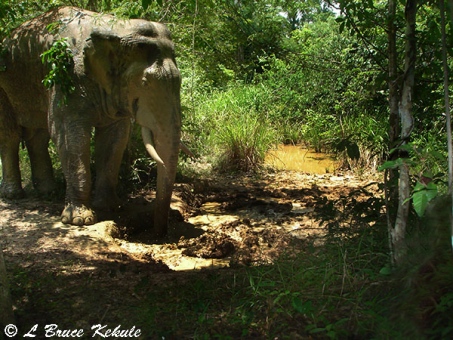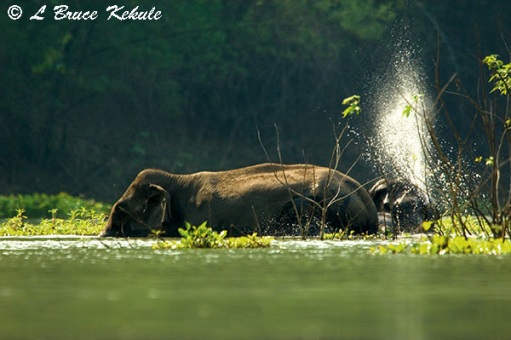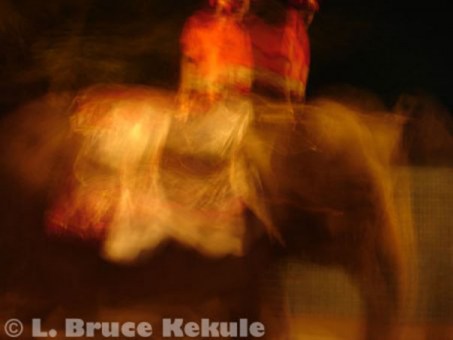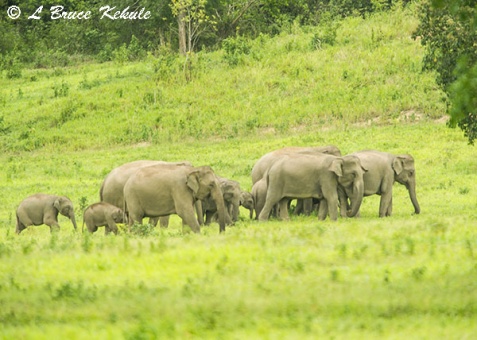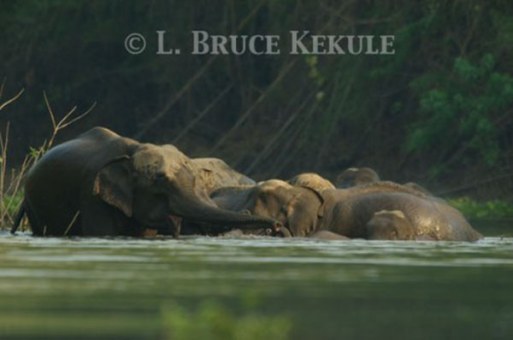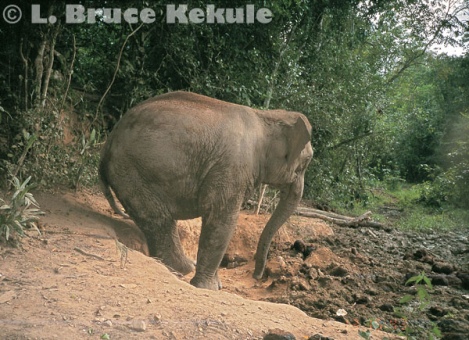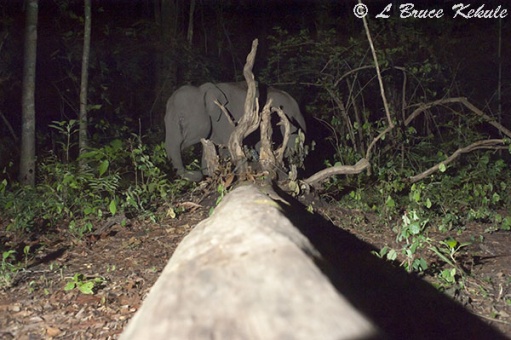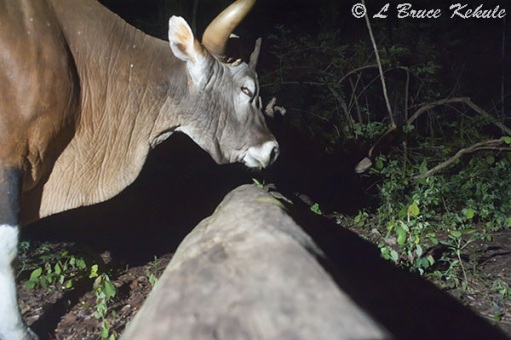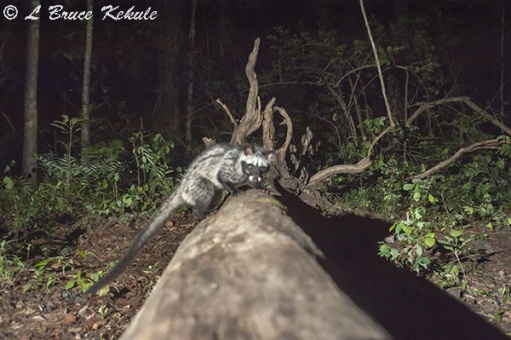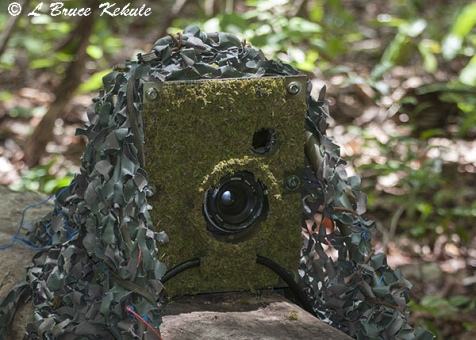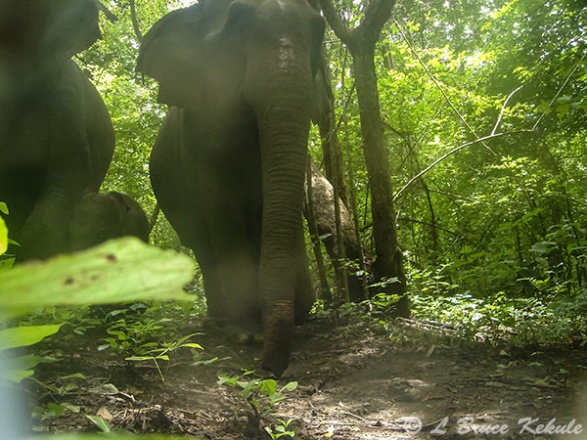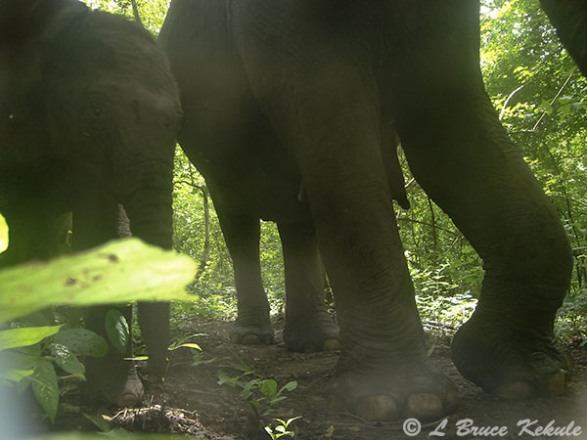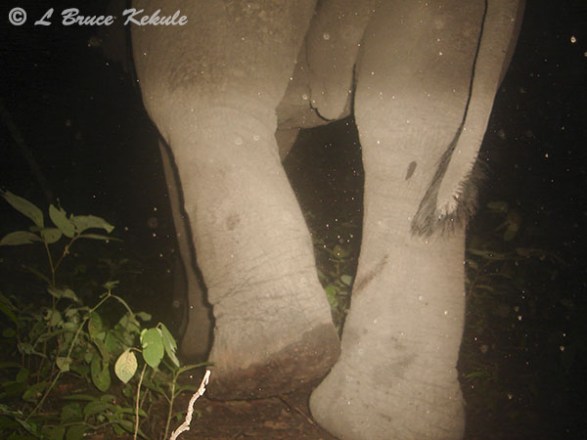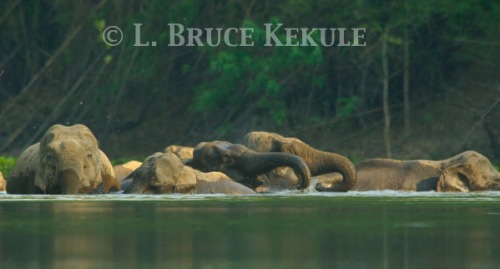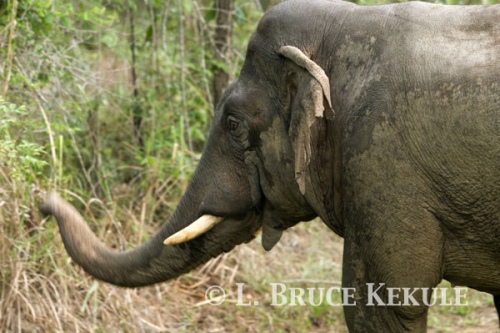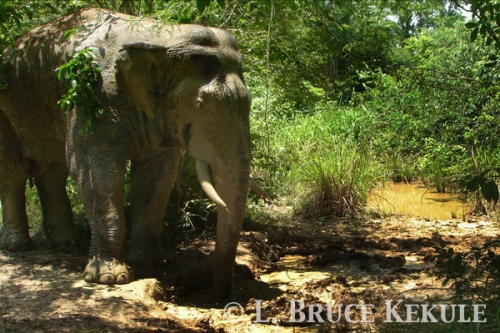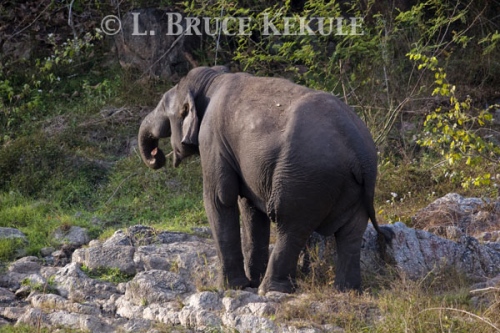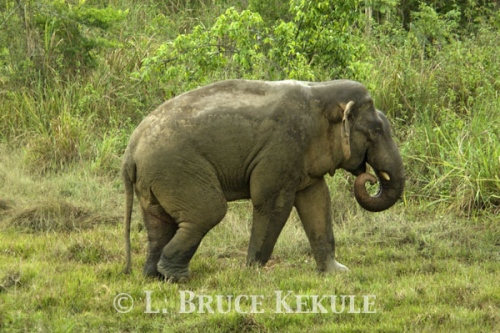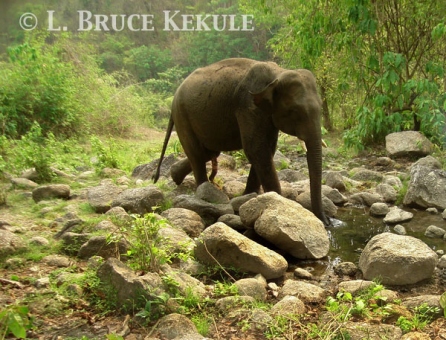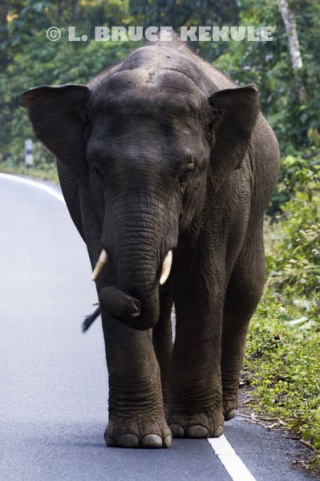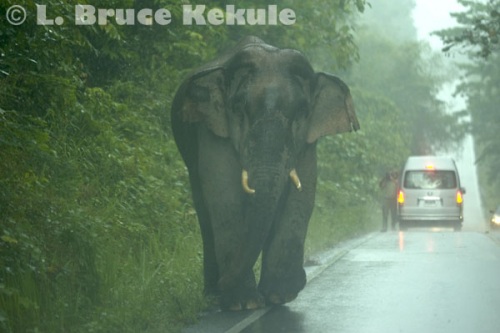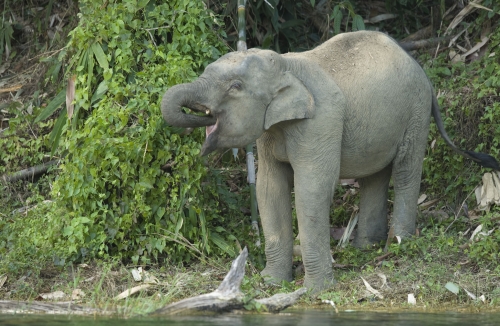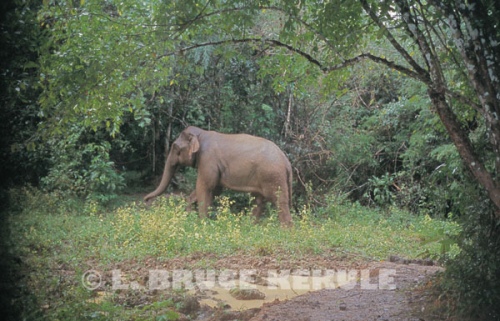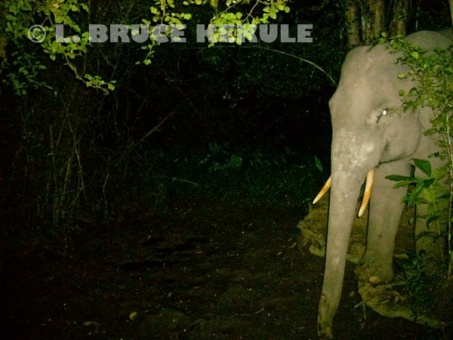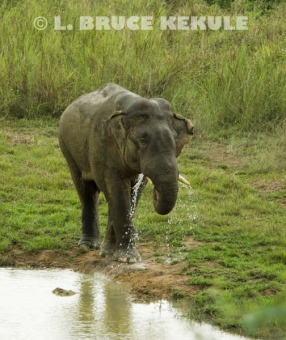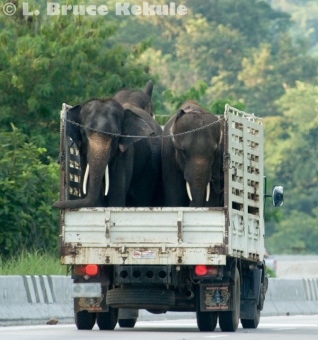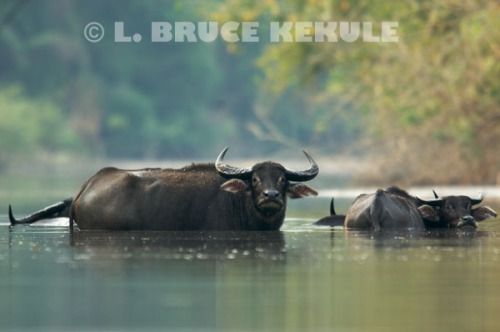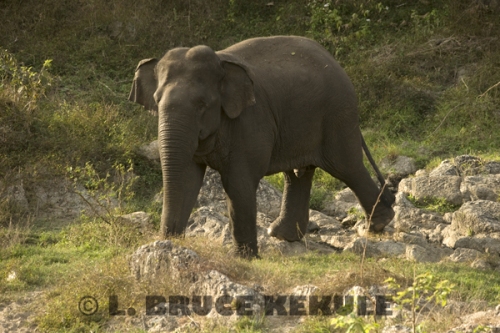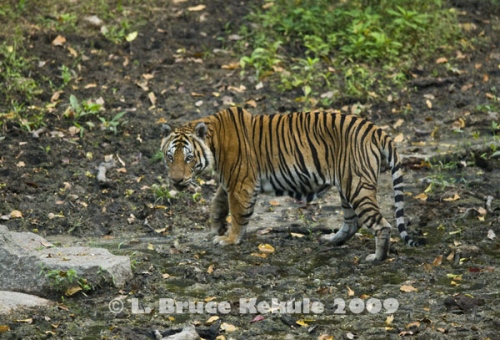Posts Tagged ‘wild elephants’
Kaziranga National Park and Tiger Reserve: The greatest protected area in the world
From a dozen great one-horned rhinos to over 2,400 individuals in just 80 years…!
Kaziranga, a UNESCO World Heritage Site is situated in the State of Assam in northeast India, and encompasses some 430 square kilometers of grasslands, wetlands and river habitat plus a buffer zone amounting to another 400 square kilometers. Over time, the Assamese have created the greatest protected area in the world.
A close-up of a rhino bull and a mynah birds looking for insects at sunset. There are
some 2,400 rhinos in Kaziranga making this place absolutely amazing in regards to
these creatures still thriving in the wild, and where one can actually see them.
A big tusker with nice ivory. There are some 1,000 elephants in the park and they
have also flourished because of the pristine habitat, food sources and great protection.
But they are also targeted by poachers but on a much lesser scale. It’s easy to see
them in all areas of Kaziranga as they go about their daily lives.
A pair of wild water buffalo cows at a waterhole. Along with the rhino and elephants,
these bovid have increased to 1,300 individuals. The Indian sub-species have the largest
horns of any creature in the world, and Kaziranga has the highest density of buffalo.
In most places, the African and Asian rhinos are in trouble and close to extinction, especially the Javan and Sumatran species. Rhinocerotidae have been on earth since the ‘Late Eocene or Early Oligocene’ (about 33 to 28.3 million years ago). Being odd-toed ungulates and herbivorous, they thrive in these grassland and wetlands that are supplied nutrients from the annual floods from the great Brahmaputra River.
This river flows from the Himalayas through the park in the northern section. This waterway is one of India’s main lifelines providing water to millions of people downstream along its entire length all the way to Bangladesh emptying into the Bay of Bengal. Annual floods bring nutrients to the land and the ecosystem is replenished.
Originally established as a reserve forest in 1908, Kaziranga was declared a sanctuary in 1916 to counter extensive poaching of the rhinoceros. In 1974, the Indian Government demarcated the present area as a national park. Then, in 2007, it was declared a tiger reserve under the Central Government’s ‘Project Tiger’ scheme.
Rhino gallery: Over four days, I photographed loads of these prehistoric looking
creatures in all three zones (West, Central and East)…! It was simply amazing…!
Eighty years ago, the rhino population was decimated to just a dozen or so beasts by poaching for their horn in demand by the Chinese and Vietnamese. The Assamese government decided to really put its foot down and instigated a policy to eradicate poachers using ‘extreme measures’ throughout the park, plus increasing the ranger force by several hundred percent.
The animal population immediately began to pick-up, and the last senses in 2014 estimated that some 2,400 rhino, 1,300 wild water buffalo and 1,000 elephant are thriving in this small park. Along with this, there are over 100 tigers that live here too and the park has one of the highest densities of the striped cat per square kilometer in the world. As a destination to see these majestic and iconic creatures, Kaziranga is the place to go.
Wild elephant gallery: I saw these herbivores every day and in all zones. There are over
1,000 of these giants in the park…!
The Assamese people are very proud of their heritage and the park is a ‘case study’ on how to actually save a species from extinction. All the large mammals propagate in safety and show the world; if you look after a place with a mandate to rid the protected area of poachers, animals will flourish. However, it turned into a small war and many people were actually killed including some rangers.
Even so in 2014, about 50 rhinos lost their horns and poachers killed three tigers. The battle continues and the government has done a brilliant job of saving nature with a tough mandate of ‘shoot to kill’ in order to protect this place.
It has worked so well that it is now possible to see rhino everyday, and just about everywhere, even outside the park. As I was leaving for the airport after four days on a recent safari in Feb. 2015, there were some cars parked by the side of the road and photographers had their cameras out taking images of a rhino a hundred meters from the tarmac.
Wild water buffalo gallery: There are more than 1,300 of these bovid and I saw them
everyday in all zones…! They have the largest horns in the animal kingdom….!
There are three zones (West, Central and East) that tourists are allowed to enter and it is scheduled by the lodge where you are staying on what areas one can visit. The Big Three (rhino, buffalo and elephants) can be seen in all areas. If you are lucky, a tiger may appear at any time. There are many bird species thriving and it is a bird watcher’s paradise.
The Park is home to more than 70 percent of the one-horned rhinoceros left in the world and harbors more than 60 percent of India’s wild water buffalo population along with the only population of Eastern swamp deer (or barasinga). Other important wildlife found are: gaur, leopard, fishing cat, large and small Indian civet, sambar, barking deer, hog deer, hog badger, Hoolock gibbon, capped langur, Assamese macaque, rhesus macaque, sloth bear, Gangetic dolphin and otter, etc.
A fresh tiger pug mark on the road in Kaziranga. I did not see a tiger here but got
a wonderful shot of a running tiger in the grassland of Corbett National Park
in northern India….!
From New Delhi, the flight to Guwhati in Assam takes about two hours and then it’s another four hours by taxi to the Infinity Lodge where I stayed situated close to the three Kaziranga park gates. There are many other hotels and lodges and one can find these on the Internet. There is also a bus service that passes the park. Traffic to the park is a bit hectic at certain times since it’s the main road in the northeast India to the next state of Nagaland, and on into Myanmar. It has been said that smugglers use this route for tiger bones and rhino horn to China.
Some of the rare birds thriving in Kaziranga: A female black stork identified by a
yellow iris near a waterhole; a Kalij pheasant in the forest; two bar-headed geese
in the wetlands, and a grey heron and pelican swimming in a pond….!
One thing for sure: the Forest Department here in Assam is one tough cookie. They have increased rangers to 700 men and women, and have 162 guard posts with 3-4 rangers living in each of these quarters. They do mainly foot patrols and are always armed with a least a rifle (mainly British .303s but some men have newer generation .315 Indian rifles that is lighter in weight than the old cumbersome English service arm) or sometimes 12 gauge shotguns. Some of the elite forest guards have assault rifles. While on any safari in Kaziranga, a forest guard with a rifle is mandatory in case of an emergency. The men do mostly foot patrols around their respective areas.
Kaziranga gallery: The park has seen some serious flooding and the most extreme levels
have been recorded shown here at a ranger station. Travel and viewing wildlife is normally
done in Maruti (Suzuki) type jeeps. Controlled burning of the grasslands carried out by the
Forest Department benefits the herbivores when new grass sprouts up….!
Needless to say, it is perfectly safe to travel in and around the park. An armed forest guard to ride ‘shotgun’ is mandatory and is picked up at the gate. For the most part, you’ll be able to see these beasts in a Maruti (Suzuki) safari type jeep called a ‘gypsy’. It is the best way to view wildlife and there are many operators at most of the lodges. The forest department also offers guided tours on an elephant-back to get up-close to the big beasts.
The best time to visit Kaziranga is from November to April. I used a Company named ‘Wilderness Uncut’ (wildernessuncut.com) for all my arrangements. Wildlife photographers Anu Marwah from New Delhi, and Jason Fernandes from Mumbai are co-owners and they organized everything to perfection. Their service is top-notch and I know who will arrange any future trips to India for me. Being wildlife photographers, they know what is needed for a successful trip.
That’s me with my naturalist Polash Borah, driver Mohammed Nekib Ali and a forest
ranger at a rest stop station early one morning during my recent safari.
I also had the pleasure of working with Polash Borah, my naturalist (17 years of experience in Kaziranga) and Mohammed Nekib Ali (10 years experience) my driver who also acts as a naturalist. We spent four days together and had a great time. They know exactly what are the best areas for viewing and photographing wildlife, and both work at the Infinity Lodge just outside the park.
May 1st is ‘World Rhino Day’ in India, and Kaziranga National Park and Tiger Reserve is the best place in the world to see these rare creatures up-close. If you are planning on visiting a protected area first hand and want to view Mother Nature’s giants, make arrangements to Assam; you won’t be disappointed…!
Travel Info:
From Thailand, one of the best airlines to travel to India is ‘Air India’ that has a daily flight leaving Bangkok around 8am and arriving in New Delhi at noon. Arriving in the daytime in Delhi is much better and safer than arriving after midnight like some of the other airlines do. A connecting flight on Indigo Airways to Guwhati in Assam is very good and takes about two hours. They are a budget airline and have several flights a day. I recommend these two carriers as being very reliable and reasonable in price. Give yourself at least three hours through the New Delhi domestic airport, as it is extremely busy and crowded. Finally, when flying a domestic airline, a maximum of 15 kilos for check-in baggage is the standard. Anything over that weight will be charged as excess.
Wild Thailand Part One and Two
For the first time, a snarling tiger shows what their reaction is to a video cam with red LEDs when actuated at night. This male tiger is a resident at this location in the ‘Western Forest Complex’…a black leopard also passed the cam several times but did not actually look at the LEDs and so no reaction was recorded.
At the second location, the tigers did not seem too bothered by the red blob…! I now have a few cams including my Nikon D700 set-up here and hopefully will catch a tiger with my DSLR trail cam…!! Please enjoy these videos and even though they are a bit fuzzy, still show Thailand’s amazing natural heritage at its best.
Thailand’s Vanishing Giants
A family unit in Khao Yai National Park.
Increasingly dangerous environment for wild elephants: An indicator species of a pristine forest
Of all the mammals in Thailand, the wild elephant is probably the most important indicator species of a disappearing wilderness. A century ago, there were more than a hundred thousand elephants found in the country when 75 percent of the Kingdom was still covered by forest. Just north and east of Bangkok, these huge mammals thrived in the marshlands and forests near the city.
But as time passed and humanity expanded creating cities and towns, roads and highways, railways, agriculture farmlands, golf courses and resorts, the home of the wild elephant began to disappear leaving many forests fragmentized and degraded. Populations of wild elephants went into serious decline. Humans are directly responsible for this loss with encroachment and poaching at the forefront. Forests and wildlife continue to disappear as we move into the 21st Century.
When Khao Yai, the first national park in Thailand was established in 1962, the Royal Forest Department (RFD) was in charge of protecting the forest. Prior to that, they controlled logging concessions and huge swathes of forest were felled in the timber business. Finally, the government stopped all logging in 1989. However, illegal tree felling is still going on to this day but on a smaller scale.
Tusker camera trapped in Khao Ang Rue Nai Wildlife Sanctuary, eastern Thailand.
Then in 1992, the Department of National Parks (DNP) was established to look after the national parks, wildlife sanctuaries, non-hunting areas and marine national parks. There are now over two hundred protected areas nation-wide.
Since then, it has taken many, many years for the department to establish some form of protection and enforcement. Patrolling of the forests has been minimal due to many factors. Unfortunately, things have been difficult for them to look after these biospheres because of low budgets and not enough personnel. Laws are seriously outdated especially when it comes to elephants.
Elephants in the Huai Kha Khaeng river blowing water.
The history of man and elephants in Asia has been intertwined for several thousand years. These majestic creatures taken from the wild have been part of human culture and beliefs. Elephants played a major role in the wars with Burma of the past. Until recently, the elephant was not only used for logging but for transport and baggage. More recently, they are used to attract tourists at camps and in cities where people use them for begging. The domestic elephant has been abused, and very badly in some cases.
Begging elephant in Chiang Mai – Abstract.
Probably the most appalling fate for a domesticated elephant is to become a streetwalker. These magnificent creatures are forced to walk hot, dusty and polluted streets of Thai cities ‘begging’ for food and money. Stories about elephants hit by cars and falling into drainage ditches, plus other accidents have been documented.
Ten years ago, it was guesstimated that 2,000 wild and 3,000 domestic elephants were thriving in the country. Due to an increased DNP and NGO interaction in the parks and sanctuaries, wild elephants have made a bit of a comeback in some protected areas. There are now (still guesstimated) to be about 3,000 wild elephants and more than 4,000 domesticated animals. Population density surveys have been carried out in some parks but exact numbers of the wild population are still uncertain.
Elephants on a truck bound for Chiang Mai.
The biggest threat to wild elephants is still the same. Poaching males for their ivory and females for their babies. Recent kills in Kaeng Krachan National Park in the Southwest have gone on for quite sometime due to poor protection and enforcement, and numbers of elephants have dropped.
Elephants in the savanna of Kui Buri National Park.
It is quite possible that they have migrated to Kui Buri National Park further south along a thin corridor along the Burmese border. Numbers in Kui Buri have increased 100 percent in the last five to ten years, and evidence of elephants in Prak Tha Kor Reserve Forest between the two parks has been documented. This area needs to be established as a protected area.
Elephant herd in Kui Buri National Park.
The following is a typical scenario of baby elephant snatching. Gunshots reverberate explosively through the forest, panicking and scattering a herd of wild elephants. The huge beasts instinctively flee as fast as they can through heavy foliage away from the cacophony. In minutes, the forest returns to normal. But the sad fact is that humans have just disrupted the herd permanently.
A large herd in Huai Kha Khaeng Wildlife Sanctuary.
A baby elephant mills aimlessly around its mother lying dead on the ground. The confused calf has no sense of danger as poachers move in to capture it to be sold on the illegal black market. The calf will likely be forced to wander city streets or work in tourist camps.
A small herd including a calf in the Huai Kha Khaeng river.
Such atrocities are still practiced by unscrupulous people intent on killing the mother solely to capture the baby. Many other animals are also hunted down in much the same way. Middleman, the ‘big-fish’ and end-use buyers perpetuate this market and seem to evade the law. When will this horror story ever stop?
A tusker and tourists in Khao Yai.
In another real-life scenario, a young tusker is killed on the road that transects the northern part of the elephant’s range in Khao Ang Rue Nai Wildlife Sanctuary in eastern Thailand. It is home to about 170 wild elephants. The road had been widened and resurfaced to enable faster speed.
Tuskless bull in Huai Kha Khaeng.
During late-evening one day in May 2002, a man and woman in a pickup truck barreling through the sanctuary at high speed did not see the elephants on the road until it was too late. The truck crashed head-on into a 5-year-old tusker. The truck’s driver was killed on impact but the woman survived. The young elephant died shortly after.
Tusker on the road in Khao Yai NP.
This young tusker was not the first and definitely will not be the last elephant to be killed by reckless driving on this road. Eventually, the local government ordered the road closed through Khao Ang Rue Nai from 9pm to 5am. The elephants come out of the forest usually only at night and can now roam safely in their own habitat. Accidents and road-kill have dropped drastically. Definitely a role model for other protected areas with elephant-human conflicts.
Another tusker on the road in Khao Yai N.P.
Such accidents are a terrible blow to the conservation of Thai elephants, because tuskers are particularly vulnerable, being subject to hunting for their ivory. Asian ivory is finer-grained than African ivory and prized for carving into trinkets and Japanese hanko (signature seals).
Herd in Kui Buri N.P.
Much of their habitat has been taken over, mainly by pineapple, sugarcane and cassava. Villages spring up in old elephant habitat, and the trespassers expect the giants to simply fade away into the forest. But elephants can develop a taste for crops grown by farmers, and they often take what they want. Countless conflicts have arisen between villagers and the real owners of the land, whose ancestors have lived there for many thousands of years.
Herd in the Huai Kha Khaeng river.
Elephants have been maimed and killed by poisoning waterholes, pungee stakes, gunshots, and electrocution. They have been chased out of rice paddies, mango orchards and farmlands. People use fireworks, bright lights and guns to scare them away temporarily, but the elephants are intelligent enough to lose their fear of such ruses.
Elephant on the highway north of Bangkok.
These giants grow bolder and go on the rampage, sometimes killing people, tearing up villages and damaging RFD and DNP facilities. Some conservation organizations have erected new signs warning of the danger of elephants in the area.
Elephant and handler begging near ‘700 Years’ Stadium in Chiang Mai.
A trip at night around some cities, one can still be greeted by a huge gray beast with a red light attached to its tail. Continuous calls for change go unnoticed by mahouts and the owners of these elephants who sneak them into tourist sites. Legislation concerning domesticated elephants remains old and out-dated, and law enforcement has also been very poor. On the positive side of things, the authorities have finally moved them out of Bangkok, but they still roam on the outskirts in some places.
Elephant in a mineral deposit in Kaeng Krachan N.P.
It is hoped that the RFD, DNP and other government organizations will draw attention to the dire situation of Thai elephants, both wild and domestic. These noble beasts have featured prominently in almost every important historical event in the Kingdom. They are a national symbol of pride and joy. The Thai elephants’ future survival lies in the hands of the government who are responsible for these amazing giants….!
Special Note:
I would like to thank Andy Merk, German wildlife photographer for the lead photograph. He has been hanging around Khao Yai for the last 20 some years and has a huge collection of elephant photos from the park. He is doing a survey of trying to get a estimate of the population by identifying individual elephants by their ears, specially the male tuskers and mature females.
Nikon D700 trail cam: The first set
Elephant, banteng, civet and bat captured
Wild elephant; not sure why the cam tripped with the jumbo on the far side of the sensor??
Went into Huai Kha Khaeng to check my D700 trail cam a couple of days ago….the weather was horrible with a big storm brewing and rain had already started to fall. I had to get in and get out.
The young elephant headed for the cam; and it tripped again.
Instead of topping up the card, batteries and desiccant, I decided to pull the unit and two flashes that were not working. One Nikon SB28 flash was still OK and I left it.
A powerful trunk that tried to move the cam but could not budge it.
After downloading the card, I got a pleasant surprise that the D700 had performed quite well on its first stint. Elephant, banteng, a civet plus a bat had tripped the cam.
This elephant ripped most of the camouflage netting off the cam.
There were some strange false triggers but I guess with bats or birds that fly through, the unit will trip to an empty frame. I was elated to say the least.
A mature banteng bull.
I will go back in a week and will move the D700 about two-three feet closer as there is too much log in the frame and the composition is still not right.
This bull looks like he is blind in the right eye.
The elephants ripped most of the camouflage netting off the cam but it survived intact and was still as solid as the log meaning they could not budge it. The moss was OK.
A bat flying through.
Needless to say, I look forward to more sets from this cam. I will be adding another flash to the right side of the log to get rid of the shadow. It is just a matter of time before a tiger or leopard jumps this log.
A common palm civet posing on the log.
Unfortunately, the civet was just inside the focal plane and therefore not in focus. But they are so common here, I’m positive I will get this critter again…! Enjoy.
The Nikon D7oo trail cam on a fallen tree.
The ‘Little Elephant Slider’
A 3-month old baby elephant slides in on the trail to a waterhole deep in the forests of western Thailand. This family unit is also made-up of several mature females and younger juveniles.
A wild elephant’s foot…!
All images by a Sony S600/S40 camera trap
Wild Asian elephant herd checking out my camera trap
The toughest test of a camera trap in Thailand’s forest is being attacked by the awesome power of a wildlife elephant. These huge beast are very inquisitive and will check-out anything that catches their eye. Camera traps are of special interest and depending on how tight the cam is on the tree, these giants will try to rip it off. The following sequence was captured last month.
Mother elephant and baby
Elephant’s rear end
Female elephant showing tushes
Elephant’s muddy foot
Another ‘mud paw’
They tried in vain to get my cam off but it was so low, they could not get any leverage so they just used their muddy ‘paws’ but failed. However, the lens and sensor were covered in mud after this. The last few shots show what an elephant’s foot looks like…!
Special interest:
This shot of a very old, old banteng bull with a damaged pair of testicles was earlier on the same setup before the elephants. No telling what happened to this poor guy. He was probably evading a predator and scratched em’ on a stick while bolting through the forest. There are big tigers here that go after the old bulls…!
This bull is very old judging from the hang on the dang….!
Asian Elephants: Thailand’s Mega Fauna
Wild Species Report
A flagship species and cultural symbol
Thailand’s largest terrestrial animal on the brink of extinction
Wild elephant family unit in Huai Kha Khaeng Wildlife Santuary
In 1927, a film was made depicting wild Thailand, and shown to audiences around the world. Entitled ‘Chang – A Drama of the Wilderness’, this epic documentary was produced by two American filmmakers Merian C. Cooper and Ernest B. Schoedsack, and released by Famous Players-Lasky, a division of Paramount Pictures.
‘Chang’ (Thai for elephant) is a melodrama and silent film about a man, the jungle, and wild animals as its cast. The main character is Kru, a poor farmer depicted in the film that battles tigers, leopards, bears and even rampaging elephants, all of which pose a constant threat to his livelihood. The saga was depicted in the northern province of Nan where thousands of wild elephants survived in vast herds at the time. The footage of elephants in the hundreds is remarkable.
Young tusker at a mineral lick in Huai Kha Khaeng
The film also shows tigers and leopards caught in pit-falls and dispatched with a muzzleloader from the top. It was an amazing piece of celluloid production where logistics must have been really tough. Chang was nominated for an Oscar for Unique and Artistic Production at the first Academy Awards in 1929. Cooper and Schoedsack went on to make the classic blockbuster movie King Kong.
Tusker in Khao Ang Rue Nai Wildlife Sanctuary
The Asian and African elephants are the only two surviving species of a once diverse and widespread group called proboscids (order Proboscidea), or animals with a trunk. They are characterized particularly by developments of their teeth and adaptation of their limbs for supporting their increasing mass. All total there is fossil evidence of some 350 species of ancestral proboscideans, mastodons, mammoths and modern elephants.
The first ancestor of elephants lived approximately 50 million years ago during the Late Eocene and Early Oligocene Epochs. It was named Moeritherium after the place where it was discovered, the Moeris Lake in Egypt. Though its form and appearance were completely different from the elephant, scientists base Moeritherium’s ancestry of the elephant on its skull and teeth. The skull had air holes, just like the elephant, and four small incisors grew from the upper and lower jaw that the growth of tusks had begun. At least three divergent groups of proboscideans evolved there from Moeritherium or close relatives.
Mature tusker camera trapped at a waterhole in Khao Ang Rue Nai
The next beast of elephantine build and bulk was the Deinotherium that was still not a true elephant. They became common in Africa, Asia and Eastern Europe during the Miocene Epoch. They were very large at 4 meters high with down curving tusks from the lower jaw. Surviving for 20 million years well into the Pleistocene Epoch, Deinotherium was clearly a very successful animal. About the same time Paleomastodon and Phiomia began to evolve and show the closet beginnings of a trunk allowing the species to feed higher off the ground.
Very old tuskless bull in Huai Kha Khaeng
At the beginning of the Miocene epoch about 24 million years ago, the ancestral Gomphotheres was the real commencement of Proboscidean diversity. There were literally hundreds of species at one point including mastodons and mammoths. Elephantidae is the family to which the modern elephant belongs and the first species was Elephas antiquus from the middle to late Pleistocene Epoch. However, by the beginning of the Holocene Epoch around 10,000 years ago, only two species remained: African elephants Loxodonta africana and Asian elephants Elephas maximus.
Tusker in Khao Ang Rue Nai
The main differences between the two species are anatomical. The African elephant are larger and has a more elongated skull, a trunk with deep rings, larger ears, a flat forehead and, in general, holds its head at a 45 – degree angel to the ground. Asian elephants are smaller and have a double – bulged forehead, a trunk with fewer rings, smaller ears and a skull with a 90 – degree orientation.
There are three Asian sub-species: the Sri Lankan elephant Elephas maximus maximus, the mainland elephant Elephas maximus indicus, and the Sumatran elephant Elephas maximus sumatranus, and two African sub-species: the bush elephant Loxodonta africana africana, and the forest elephant Loxodonta africana cyclotis.
Young tusker camera trapped at a waterhole in Huai Kah Khaeng
Prehistoric fossil evidence of proboscideans has been discovered in the north, the northeast, the central plains, and the south of Thailand. The first find in 1948 was fossil bones of Stegodon insignis (mastodon) during the construction of the bridge across the river just south of Nakorn Sawan provincial city. Following this, discoveries were made in lignite deposits in Lamphun, Lampang and Phayao provinces. Fossil teeth of a Deinotherium at Ban Sop Khan in Phayao have been uncovered. Another find new to science is the earliest known species Stegolophodon praelatidens fossils from the Early Miocene discovered in Lamphun and Lampang by Pascal Tassy (from France) and others.
Many extraordinary ancient proboscidean fossils have been unearthed in Nakhon Ratchasima (Korat) province at the Tha Chang and Chang Thong sand pits along the Mun River in Chaloem Prakiat district going back to the middle Miocene about 16 million years ago. Eight different genera of proboscideans have been discovered here and is a testimony to the Kingdom’s fossil record.
Family unit in Huai Kha Khaeng
About 150 years ago, wild elephants were surviving around Bangkok along the Chao Phraya River, and in the districts of Rangsit, Bang Sue, Bang Kapi and Bang Na. The ‘City of Angles’ was a real jungle back then. It seems difficult to believe but in those days, Thailand was almost completely covered by forest cover – more than 90 percent. Today, only 30 percent remains. Due to the immense destruction, elephants have been at the forefront of a disappearing habitat.
The best current estimates say there are no more than 2,500-3,000 elephants surviving in the wild of Thailand today. There are 60 protected areas that have less than a hundred elephants, and another eight protected areas that have over one hundred individuals as follows: Huai Kha Khaeng Wildlife Sanctuary – 280-300; Khao Yai National Park – 200; Khao Ang Rue Nai Wildlife Sanctuary – 230; Salak Phra Wildlife Sanctuary – 175-200; Phu Luang Wildlife Sanctuary – 100; Phu Khieo Wildlife Sanctuary – 135; Kui Buri National Park – 150 and Kaeng Krachan National Park – 115. Surely, an up-to-date consensus of the wild elephant population should be undertaken by the Department of National Parks, Wildlife and Plant Conservation (DNP) in all the forests throughout the Kingdom, and a report published as soon as possible. As it stands, many of these quotes are mere guesstimates.
Young tusker on the road in Khao Yai National Park
Elephants have been persecuted for a long time. The following scenario has been chosen for this column and has been carried out for decades in Thailand’s forests, and unfortunately is the dark side of nature that carries on to this day. Gunshots reverberate explosively through the forest panicking and scattering a herd of wild elephants. The huge beasts instinctively flee as fast as they can through heavy foliage away from the cacophony. In minutes, the forest returns to normal but the sad fact is humans have just disrupted the herd permanently. A baby elephant mills aimlessly around its mother lying dead on the ground. The confused calf has no sense of danger as poachers move in and capture it to be sold on the illegal black market. The calf will likely be forced to wander city streets or work in tourist camps.
Such atrocities are still practiced by some unscrupulous people intent on killing the mother solely to capture the baby. Many other animals are also hunted down in much the same way like gibbons and monkeys. Middleman and end-use buyers perpetuate this market and seem to evade the law. Wildlife black-market trading is fueled by a few shady individuals and is on-going. Great strides have been achieved by a few wildlife enforcement agencies and many arrests have been made in recent years exposing these law-breaking individuals. However, the so-called ‘big fish’ continue to do business as usual. It is a never-ending battle!
Mature tusker on the road in Khao Yai
In another scenario, a mature bull elephant with a large set of tusks tramples and gores a man deep in a protected forest many days walk from the nearest village. News travels fast but is subdued by the authorities due to the sensitive nature of the incident. The man was with a group of poachers hunting the tusker and he was armed with a crude muzzleloader. He was separated from the group and came upon the huge herbivore firing a shot, which only enticed the old bull to charge. It was all over in seconds and when the man was found critically injured the group rushed him to the nearest medical facility but it was too late. The villagers cried fowl and hunted the old bull down eventually taking his tusks and selling them to a middleman for pennies compared to what they would fetch from a rich end-user or agent. This has been going on for ages to feed the illegal ivory trade.
Human settlement, agriculture and roads have taken over much of the elephant’s habitat. Villages spring up in old elephant terrain, and the trespassers expect the giants to simply fade away into the forest. But elephants can develop a taste for crops grown by farmers, and they often take what they want. Countless conflicts have arisen between villagers and the real owners of the land, whose ancestors have lived there for many thousands of years. Thailand is not alone to crop-raiding elephants. Other countries in Asia and Africa have experienced the same outcome when humans have taken over elephant land.
Very young tusker about five years old in Khlong Saeng Wildlife Sanctuary
Most of the conservation areas where wild elephants live are just small isolated pieces, and agricultural areas or towns surround these forests, a major obstruction to natural breeding. Elephants in each forest are caught on islands and cannot walk back and forth between these areas. Thus, inbreeding among close relatives is inevitable, which leads to an inferior population and causes genetic diseases, and ultimately, to extinction. Belinda Stewart-Cox with Elephant Conservation Network has campaigned relentlessly for the establishment of a corridor between Salakpra and Srinakarin protected areas in order to prevent the total isolation of Salakpra’s elephants. Other corridors in other parts of Thailand are on the drawing boards.
The young tusker a month earlier
Elephants have been maimed and killed by poisoning, pungee stakes and pit-falls, gunshots, and electrocution. They have been chased out of rice paddies, mango orchards, and pineapple and tapioca fields. The use of fireworks, bright lights and gunshots scare them away temporarily, but the elephants are intelligent enough to lose their fear of such ruses. Elephants grow bolder and go on the rampage, sometimes killing people, tearing up villages and damaging DNP facilities usually during the dry season when water is scarce.
Nick-named ‘Nong Saeng’ after the sanctuary
This year, a herd of wild elephants in a western national park raided a village and broke into a shack with fertilizer. A young calf gorged itself and died shortly thereafter. On the other side of the spectrum, an old tuskless bull killed a ranger in western Thailand, and a tusker gored a villager in the East. Wild elephants have also died or been injured accidently by vehicles speeding on roads in some protected areas. Most of the accidents occur at night when the elephants are difficult to see. Some conservation organizations have erected new signs in some areas warning drivers the danger of elephants on the road at night.
Mature tuskless bull in Kaeng Krachan National Park
These noble beasts have featured prominently in almost every important historical event in the Kingdom. They are national, royal, and religious icons of Thailand. The ‘white elephant’ was on the flag of Siam. They are a national symbol of pride and joy. The Thai elephant’s survival lies in the hands of those responsible for these vanishing Asian giants. Proactive conservation awareness is a top priority for the government and existing outdated laws (some a hundred years old) need to be reviewed and changed for the elephant’s future. Strict penalties and fines for poaching and encroachment need to be enforced to insure the survival of nature’s largest terrestrial mammal in Thailand before it is too late.
Ecology and behavior of elephants:
“Tractors of the forest” is what the late Mark Graham called wild elephants in his excellent book entitled ‘Thailand’s Vanishing Flora and Fauna’ co-authored by Philip Round, the eminent bird ornithologist. Graham went on to say “in all parts of Khao Yai National Park there are trails which have been used by herds of elephants for, in all probability, thousands of years”. This trait is evident throughout continental Thailand where these creatures roamed.
Tusker about 25 years old in Kaeng Krachan
Asian elephants consume 75-150 kilograms of food and about 80-160 liters of water per day. A variety of grass species including bamboo is consumed, as well as tender twigs, barks, leaves and fruit. Natural mineral deposits are also very important to these herbivores supplementing their diet. An adult mainland Asian elephant may reach a height of 3.5 meters and weigh 5,000 kilograms. Elephants form family units but lone bulls are common. Male elephants have tusks but tuskless bulls are now quite common and can be very bad tempered, especially if the bull is in a state known as ‘musth’ where fluid leaks from the temporal gland.
Mature tusker at a waterhole in Khao Ang Rue Nai
Reproduction of the Asian elephant is the same as the other sub-species. The young are born after a gestation period of 18-22 months. Elephants usually give birth to a single offspring, rarely twins, and more rarely triplets. A female elephant can give birth every 4-6 years, and has the potential of giving birth to seven offspring in her life. Life expectancy for elephants is 60-70 years.
Elephants in domestication:
Elephants are extremely intelligent creatures. For centuries, humans have taken elephants from the wild and turned them into many different uses such as war elephants, working elephants at logging sites, as pets, tourist attractions and street beggers.
Elephant on the highway in Ayuttaya province
My very close friend Richard Lair who works for the Forest Industry Organization at the Conservation Center in Lampang has worked with elephants for many years. He was the first to get elephants to paint in Thailand, and the first in the world to establish a musical band made up entirely of elephants. He has produced several CD’s of this accomplishment.
Begging elephant near the 700 year stadium in Chiang Mai
Probably the most appalling fate for a domesticated elephant is to become a ‘street walker’. These magnificent creatures are forced to saunter hot, dusty and polluted streets of Thai cities ‘begging’ for food and money. Stories about elephants hit by cars and falling into drainage ditches, plus other accidents have been documented. At one time, a trip at night around Bangkok and other cities in the Kingdom one was greeted by a huge gray beast with a red light and a flashing CD attached to its tail. Continuous calls for change went unnoticed by mahouts and the owners of these elephants who sneaked them into cities and tourist sites. Legislation concerning domesticated elephants remains old and out-dated, and law enforcement has also been very poor.
Domesticated elephants being trucked into Chiang Mai
In late-2010, I saw an elephant on the streets of Chiang Mai at night. I took a few photographs but just watched as the mahout and elephant went about their business of begging for money. However, the situation has improved and there are several new sanctuaries dedicated to helping both mahout and elephant. It seems that most of the elephants have left Bangkok but they are still found in the out-lying areas. Hopefully, one day, the street-walker will be a thing of the past and these magnificent creatures will be treated with the respect, love and admiration they deserve.
Elephant with handlers on the streets of Chiang Mai – An abstract




